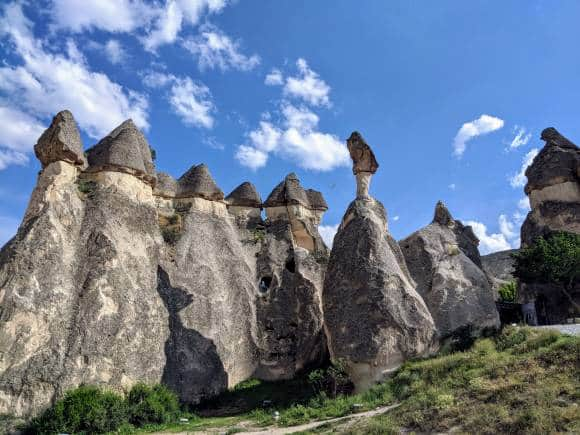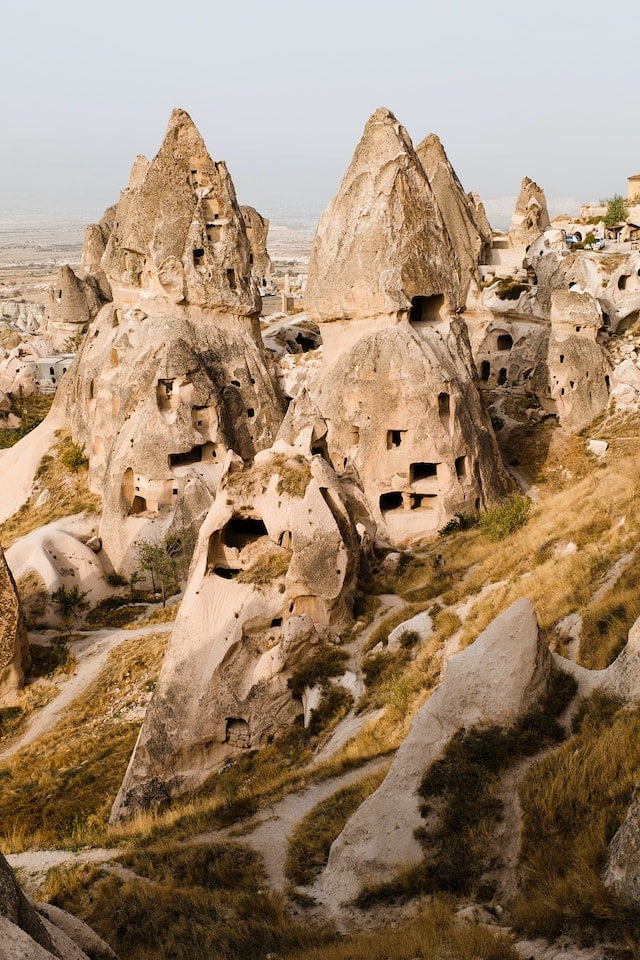



“People believe that fairies lived here,” says Eyyüp Korkmaz. My local Turkish guide in Cappadocia has a deadpan expression and a flair for dramatic dialogues. Given our surroundings, the theatrics are not unwarranted.
Pictures of Cappadocia often grace magazine covers – surreal images of hot air balloons studding the sky, and beneath them, slim towers of rock rising from the earth. I’m transported right into this picture postcard of a scene in the Paşabağ Valley, where I’m standing under the incredible “fairy chimneys” that are the most defining feature of Cappadocia’s topography.
 Paşabağ Valley's “fairy chimneys”.
Paşabağ Valley's “fairy chimneys”.
These conical rock formations rise from a land that has been shaped by the elements for millennia. Centuries ago, volcanic eruptions and the resulting lava flows gave rise to an undulating landscape of soft volcanic tuff, topped by hard magma. Wind and water erosion left behind slender, mushroom-shaped rock spires with conical basalt caps. The setting is straight out of a fantasy novel.
Ancient settlers carved homes and chapels into the soft stone, and driving through the countryside, I see the remnants of doors and windows form intriguing patterns in the bare rock face.
Cave dwelling in Cappadocia was common until as recently as the 1960s, Eyyüp tells me. Today, these rock homes have been converted into trendy stays, and the region has a profusion of cave hotels, such as the Kale Konak, where I’m staying.
Flying high
Capitalizing on this ethereal countryside, hot air balloons rise into the skies at dawn, giving travellers a bird’s eye view of the moonlike landscape. Ballooning in Cappadocia is unlike anywhere else in the world. The rose-tinted dawn sky is dotted with a hundred colourful balloons gently gliding up.
As day breaks, magnificent views unfurl below: the grand Red Valley, streaked with red and green from magnesium and copper mineral deposits; the Pigeon Valley, where the rock face is riddled with little holes, used to house pigeons and gather their excreta as highly valued fertilizer; and endless, close-up views of sinuous valleys and the ever-fascinating fairy chimneys.
 Hot air balloons rise into the skies at dawn.
Hot air balloons rise into the skies at dawn.
Salts of the Earth
Cappadocia’s barren landscape may seem harsh and inhospitable, but human resilience has proved otherwise. Nowhere is this aspect more apparent than at the Göreme Open Air Museum. Here, nature has sculpted an otherworldly panorama of craggy rock towers and sweeping valleys. Within these magnificent volcanic structures, ancient civilizations chiselled out churches and monasteries, created frescoes and carved chapels.
Dating back to the 10th century, the outdoor museum is a cluster of rock-hewn structures that provide fascinating insights into the life of the Byzantine Christian population that once inhabited these parts. Wandering through low rock chambers, I marvel at the remnants of centuries-old Byzantine frescoes, depicting biblical scenes painted with red ochre.
 (Photo by Shvets Anna via Pexels)
(Photo by Shvets Anna via Pexels)
Deeper Underground
Cappadocia is home to several underground cities – ancient engineering marvels that are an example of human fortitude. Civilization in these parts dates back to 2000 BC, with the rise and fall of several empires, including the Hittites, Persians, Byzantines, Greek, and Ottomans.
Underground cities were created as shelters to evade marauding armies. Inhabitants would migrate beneath the ground, often for months at a stretch, to live in a subterranean world of tunnels and chambers. The theory goes that the underground dwellings were used repeatedly over the ages, and date back to the 7th century, when they were first used by the Byzantine populace to evade attacking Arab armies.
Many underground cities are still under excavation and exploration, and of these, the World Heritage Kaymakli Underground City is among the best to explore. The city is around eight storeys deep, an underground layer cake connected by sloping tunnels. Half of these levels are open to tourists, carefully signposted and illuminated by lamps.
As I begin my descent into the dimly lit caverns, I’m amazed at the ancient technology on display. Oxygen comes through a ventilation shaft, descending up to 100 metres deep into the ground. The city grows in layers around the shaft, with access to underground water, a complex sewage disposal system using limestone and dry sand, a similar method for graves, massive storage vaults for food, stables on the higher levels for animals, and huge stone jars to store liquids like oil and wine.
Here in the very heart of Turkey, nature has shaped an incredible landscape unlike anywhere else in the world. Within the earth’s folds and towers, civilizations have thrived, and man has achieved magnificent feats of survival and creation. The labyrinth of underground cities, cave dwellings, and art-filled rock churches are a testament to this fact. In Cappadocia, it is difficult to ascertain whether it is natural or human artistry that is the greater phenomenon.
Discover the latest Business News, Sensex, and Nifty updates. Obtain Personal Finance insights, tax queries, and expert opinions on Moneycontrol or download the Moneycontrol App to stay updated!